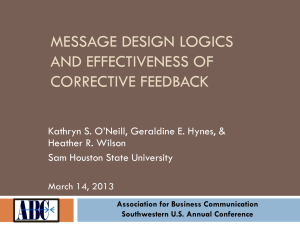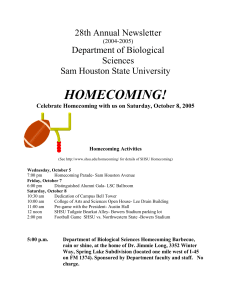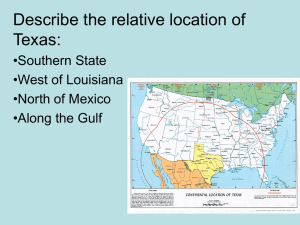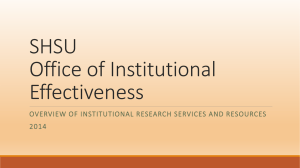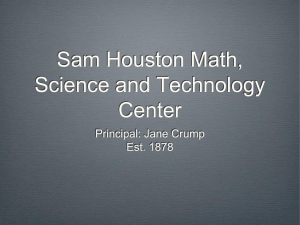Homecoming Activities - Sam Houston State University
advertisement
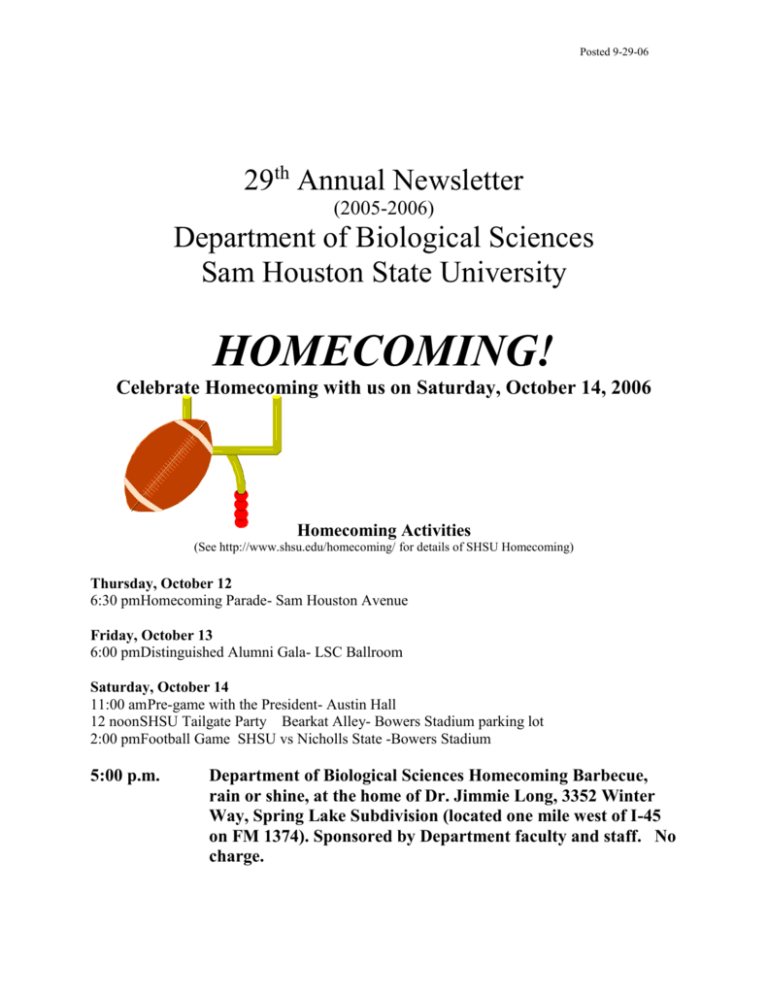
Posted 9-29-06 29th Annual Newsletter (2005-2006) Department of Biological Sciences Sam Houston State University HOMECOMING! Celebrate Homecoming with us on Saturday, October 14, 2006 Homecoming Activities (See http://www.shsu.edu/homecoming/ for details of SHSU Homecoming) Thursday, October 12 6:30 pmHomecoming Parade- Sam Houston Avenue Friday, October 13 6:00 pmDistinguished Alumni Gala- LSC Ballroom Saturday, October 14 11:00 am Pre-game with the President- Austin Hall 12 noonSHSU Tailgate Party Bearkat Alley- Bowers Stadium parking lot 2:00 pmFootball Game SHSU vs Nicholls State -Bowers Stadium 5:00 p.m. Department of Biological Sciences Homecoming Barbecue, rain or shine, at the home of Dr. Jimmie Long, 3352 Winter Way, Spring Lake Subdivision (located one mile west of I-45 on FM 1374). Sponsored by Department faculty and staff. No charge. News from the Chair It has been a banner year for the Department of Biological Sciences. Two of the three top honors given annually by the University were awarded to Biology professors. Dr. Everett Wilson was presented with the Outstanding Service Award for his self-sacrificing efforts to provide talented but underprivileged foreign students a chance at success here at SAM. And Dr. Bill Lutterschmidt won the Outstanding Researcher Award for his stellar scientific achievements; Bill, a physiological ecologist whose specialty is snakes, has been averaging almost five publications per year. These two richly deserved honors reflect the collective talent of the entire department, which has been generating peer-reviewed scientific publications at more than twice the national average of faculty at comparable institutions. Ms. Kelly Byrd, the Department’s talented administrative assistant, literally scrambles through her day handling, among her many other duties, the three-dozen plus external grants awarded to a dozen different professors; acronyms including NSF, NIH, and USDA are now in everyday use over at the University’s Office of Research and Sponsored Programs because of the successful “grantsmanship” of Biology Department faculty. The various professional societies to which the faculty belong frequently solicit their expertise for peer-review; four of our members serve as editors or associate editors of their professional journals, and a half dozen are officers in their professional societies. Faculty in the Department of Biological Sciences are, in short, a dedicated group of scholars actively engaged in, and meaningfully contributing to, their respective subdisciplines, from animal behavior to virology. Research would be hollow, however, if it didn’t enhance our teaching, if it wasn’t shared with our students, if our love of discovery wasn’t somehow used to infect the next generation with this passion. And faculty in this wonderful department have been stunningly successful at passing on this passion, many examples of which can be seen in the “News of Graduates” section following this commentary. The Department is well-represented by past students who are now themselves professors of biology, medics serving in Iraq, environmental scientists with major corporations, high school science teachers, physicians, veterinarians, laboratory managers, and, most importantly of all, engaged parents and thoughtful citizens. Not surprisingly, one of this year’s university-wide Distinguished Alumni is a biology graduate; Dr. Tarek Souryal, an internationally recognized surgeon and a specialist in sports medicine, received his BS in Biology in 1977. The strength of a department can be measured by the character and integrity of its graduates. We, the current and past faculty in the Department of Biological Sciences, are genuinely proud of our alumni, and we are honored to have played at least some small role in your successes. This year has not, however, been without challenges. University enrollments continue to grow, and space thus continues to shrink. To accommodate our three new faculty members (please see the “New Faculty” section below), the Department had to convert a teaching lab and a lab prep room into research labs. Robbing Peter to pay Paul is not a sensible business model. The Department of Biological Sciences is in desperate need of a new building (let’s make it “green”!), but we have yet to convince the upper-level administration of either our requisites or our merit. And even though the administration has been generous in giving us new faculty to meet the needs of our growing student body, there has been no relief for our over-worked staff, who are good-naturedly absorbing the increased workloads that come with larger enrollments, more faculty, new grants, more research, additional travel, and larger payrolls. Given that the number of college-bound Texans is projected to increase by an additional half-million students in the next decade or two, with many of these new students hoping to attend SAM, I openly worry about the ability of our infrastructure to keep pace with our growth. Another challenge is the rising cost of a college education. Over half of the students at Sam Houston State are the first in their families to attend college. Many face financial hardships. The Department of Biological Sciences has benefited from a dozen endowments established by previous faculty members, past chairs, and caring alumni. These endowments are used to provide financial assistance to deserving students, and we dispersed almost $20,000 in scholarships last year. This is an outstanding achievement, but we can and must do better if we hope to narrow the “education gap.” I am pleased, therefore, to announce the creation of a new endowment that will be used for biology scholarships, the Everett Wilson Biology Endowment Fund. Dr. Wilson established the fund in honor of his father, Clarence Wilson, a farmer with a sixth grade education who encouraged his son to attend college. Dr. Wilson used the honorarium he received as part of his Outstanding Service Award, matched by a personal donation, to establish the fund. I would like to encourage current and past faculty and alumni to consider contributing to this or any of our other scholarship endowments. Let me close by extending a heartfelt welcome to our three new faculty members and their families; Dr. Chad Hargrave and Dr. Raelynn Deaton; Dr. Patrick Lewis, his wife Rebecca, and their new son Teddy; and Dr. Chris Randle and his wife Dr. Sibyl Buchelli. I hope to see y’all at the picnic! Dr. Matthew Rowe Professor and Chair Department of Biological Sciences News of Graduates (We are pleased with all the responses from our graduates. We enjoy hearing from you and sharing your news with others through the newsletter. Please continue to send in your news.) Lauren Smith (BS 2006 BIO ) completed a senior honors thesis with Dr. Todd Primm Over this past summer, she participated in a summer research program at the Harbor Branch Oceanographic Institute in Ft. Pierce, Florida. She is now in vet school at Texas A&M University. Robert Puckett (BA 2000, MS 2003) is in his fourth year working on a Ph.D. at Texas A&M University with Marvin Harris. He is working on a project studying the phorid flies that parasitize the red imported fire ant. Melissa Layton (BS 2001, MS 2004) is in her second year working on a Ph.D. at Texas A&M University with Julio Bernal. Melissa is working on a biological control project that deals with the leafhopper that transmits Pierce’s disease to grapes. KC (Wendler) Deaver (MS 2004) has accepted an internship with the FBI. Colette Witkowski (BS 1983 BIO) is Associate Professor of Biomedical Sciences at Missouri State University in Springfield, MO. Colette received the Ph.D. degree from University of Arizona in 1995 and from 1995 to 1999 was an NIH Fellow at the Northwestern University Medical School. Marsha (Muecke) Young (BS 1997 BIO) and husband, Russell, have recently moved into their new home in The Woodlands. They have two children. Alisha (Smith) Lawson (BS 2005 BIO) reported to Dr Wilson that “I am currently working at the Ellen Trout Zoo in Lufkin, Texas, and two of the juvenile spectacled owls I helped to raise were shipped to Belize last week! … and … the black jaguar at the zoo in Belize was also born in Lufkin.” Stacey Black (BS 2000/1 BIO) recently emailed Dr. Wilson from Iraq: ”I'm doing well. 5 months down, 2 more to go!! It's been quite an experience. I'm responsible for the primary & emergency care of 225 Marines, plus I also take care of the flight physicals for an Army squadron that doesn't have a flight doc. I've been the flight surgeon for an aviation mishap board for another squadron …. But, dealing with the heat, the bugs, water shortages (so we take water bottle showers), and port-a-potties definitely gets old after awhile!!” Gerald Gimber (BS early 1970s ESC ) reported to Dr. DeShaw last fall that he is completing 30 years and is about to retire at Dow Chemical where he is the coordinator for the Environmental Health and Safety Department at the Freeport plant. According to Dr. DeShaw, while still a student Gerald “loved to sneak off to go fishing. He told me that when he retires, he is going to be a fishing guide on the Gulf Coast.” W. J. Reavis (BS 1995 ESC) reported in a phone conversation with Dr. DeShaw that he is the project leader for MWH on the new surface water treatment plant off of Beltway 8 near Humble. Todd Dehm (MA 1993 BIO) and Katy Dehm (MA 1993 BIO) moved to Ellsworth, ME, last spring. Katy reports that “Todd was offered a job at The Jackson Lab in Bar Harbor. It is a very good position with the opportunity for upward movement in the future. He will be in charge of a lab that deals with quality control of transgenic mice and knock out mice. It is a core lab so it isn't dependent on research grants.” Katy continues to teach at St. Joseph’s College Brian Moore (BS 1999 ESC) reported to Dr. DeShaw that he is back with Dupont as Senior Environmental Scientist and does much out-of-state travel in his job. Also, Brian is an Environmental Science Officer at the rank of First Lieutenant in the Army reserve. In his note to Dr. DeShaw, Brian says “I owe you and Sam Houston State University for all my success, and I am indebted to you and the school. He and his wife have two children and reside in Conroe, TX. John Phenix (BS 1981 ESC) passed away in March of 2006. Condolences are extended to his family. Ricky (Rick) Neal Johnson (BS 1995 ESC) received an M.S. Degree in Environmental Management from the University of Maryland last spring. He is now Senior Environmental Scientist in the Entergy Corporate Office. Jesse Truax (BA 1999 BIO), in a note to Dr. Dewees, reports that “I am currently a high school science teacher teaching Integrated Physics and Chemistry at Round Rock ISD north of Austin. When I got to SHSU you were my advisor, and I thought at the time that you were unnecessarily hard on me and very unreasonable. Because you did this, the level of my effort, academic success and meaningful learning increased exponentially. I ended up graduating with honors from SHSU with a degree in Biology, and later, … a Masters of Education, …with honors as well. Because of this experience (and current pedagogy practices), I maintain high expectations for my students now. You made a huge, positive impact on my life, and no telling how many others. I pass your wisdom on to my classes (sometimes painfully).” Ed. Nice to hear! Johnathon R. (Bert) Dodd (BS 1971 BIO) responded to our fall 2006 Homecoming notice with the following: “After 26 years of private practice in Austin, Texas I have joined the ranks of academia by selling my practice and moving to TAMU to start a new department of small animal dentistry within the college of veterinary medicine. This new endeavor began March 1, 2006. My wife and I graduated from SHSU in 1971 and…. I joined the USAF and served for 4 years. After separation I applied to veterinary school at TAMU and graduated in 1979. We have a son, Robbie (33), and 2 daughters, Melissa (28) and Carrie (26) who are all married. Carrie marred a May 2006 SHSU grad!! Carol, Carrie and I got to visit with Dr. Long in May (during graduation) and he gave us a tour of the biology dept and campus. What a treat that was and what a wonderful man he is. Carol and I will try to make the homecoming party on Sat the 14th” Tim O’Brien, M.D. (BS 1986 BIO) and Wanda O’Brien (BS 1987 BIO) reported this fall that they “are living in Dobbin, TX, just west of Montgomery on an 181 acre farm. Tim is an Emergency Medicine physician at Conroe Regional Medical Center while Wanda stays home with the 5 children.” …, ranging in age from 3 to 15, who are being home-schooled by Wanda. The children are involved with 4-H projects, raising cattle and chickens. “Tim is loved by all of his fellow workers in the ER and just loves the position he is in. We hope to be here for a very long time.” Stephen Twidwell (MA 1971 BIO) responded to our fall Homecoming notice that he “retired from the Texas Commission on Environmental Quality after 33 years of service. In his career with the TCEQ, Stephen sampled nearly all of the major streams, reservoirs, estuaries and bays in Texas. He went back to work for the Department of State Health Services after a short threemonth retirement to collect fishes, crabs, and oysters to determine if they were safe for human consumption (edible tissues checked for contaminants). Stephen changed jobs again in November 2005, becoming a fish kill investigator for the Texas Parks and Wildlife Department in San Marcos. He covers a vast 71 county region that stretches from Austin to El Paso and includes San Angelo and Del Rio.” Thanks for the update. When will you retire? Biology Major Awarded the SHSU Faculty Centennial Scholarship Amanda Lucas, senior BIO major from Spring, Texas, was awarded the Faculty Centennial Scholarship last spring. She has maintained a 4.0 GPA as a Biology major/Chemistry minor. According to her award letter, “This scholarship is designed to honor the most outstanding undergraduate student at Sam Houston State University. It was the opinion of your department and of the Faculty Centennial Scholarship Committee that you should receive this award. The award will be $400 per long semester as long as you continue to meet the eligibility requirements as an undergraduate student at SHSU.” Congratulations to Amanda! Tarek Souryal named SHSU Distinguished Alumnus Tarek Souryal, a 1977 graduate with a Bachelor of Science degree in biology, was named as one of six Distinguished Alumni by the University and will be recognized at the Distinguished Alumni Gala on October 13, 2006. Congratulations to Tarek for his accomplishments and this honor! (The following is the university news release published at Sam@Today on the SHSU website to recognize Tarek as a 2006 Distinguished Alumnus): Tarek is a nationally- and internationally-recognized orthopedic surgeon who not only works on professional athletes but provides free medical assistance to amateur athletes as well. The son of an immigrant who came to the United States in the 1960s, Tarek did not speak any English until the age of 10. His father, Sam Souryal, is a professor of criminal justice at SHSU. Tarek began distinguishing himself while at SHSU, serving as a senator in the Student Government Association, president of the Lowman Student Center Program Council, helping to establish a chapter of Kappa Sigma fraternity and graduating in three years. He was accepted at the University of Texas—San Antonio, one of three medical schools that accepted him. As an orthopedic surgeon, he writes on orthopedic medicine for professional journals and lectures throughout the world on knee injuries. Tarek is director of the Texas Sports Medicine and Orthopaedic Group in Dallas and has been the team physician for many professional athletic teams. He is currently in his 14th year as head team physician for the Dallas Mavericks basketball team. He also hosts a radio show for ESPN radio called “Inside Sports Medicine” since 2002 and is writing a book entitled “The Weekend Warrior’s Guide To Sports Injuries.” “Tarek has not forgotten, and will never forget, his modest beginning,” a nomination letter said. “He is a great philanthropist; he offers medical assistance (for free) to several high schools in and around the Dallas area and refuses to charge those who cannot pay for medical attention.” He expanded his philanthropic endeavors in 2004, when he established the Texas Sports Medicine Foundation, a charitable organization to help financially disadvantaged high school athletes with medical bills. Tarek and his wife, Karen, have three children. TriBeta News S.H.A.M.O.S News S.H.A.M.O.S., which stands for Sam Houston association of medically oriented students, is the medical club here at Sam. We attract and welcome all pre-professional students interested in pursuing any field in medicine and currently our club has 58 of these students. One of the clubs’ previous presidents, Brad Goldem, has just graduated from nursing school at Texas Tech University. Diana Hook, another one of our presidents, was accepted into medical school in the spring of 2006. Our usual semester activities consist of: Non-perishable food items, which can literally fill a truck and does so every semester, are donated during our food drive to the Huntsville Good Sheppard Mission. Every homecoming, we volunteer at Dr. Long’s homecoming party in conjunction with Tri-Beta. We host a blood drive with Gulf Coast regional blood center every semester in the LSC ballroom. In the spring of 2006, we had 83 attempting donors and 71 blood donors. We host a picnic at our faculty advisor’s house, Dr. Karlöis R. Bagdonas, a social gathering where all the biology professors and students are invited. Our fundraisers include a bake sale and a rock “N” bowl which are held every semester. Last year, we volunteered at the Children’s Medical Hospital in Houston and we are currently trying to set up another visit. Also in the past, we have had guest speakers come talk to the club to expand our knowledge of the jobs present in the medical field. Last year we had a joint speaker with Psi Chi, the psychology club, and invited a geriatric psychologist to give a presentation. We also had a nurse practitioner as a speaker, and Dr. Primm, a biology professor here at Sam, gave a great presentation advising us on the admission process to medical school. This semester, information was presented to us from an EMS/medical training specialist, and we are currently working with him to set up a CPR class for the club. Some of our other future plans for the fall 2006 semester include visits to medical schools, other guest speakers, and tailgating at football games as a chance for the club to connect socially. On October 3rd, we are having a representative from the Navy come talk to the group about scholarship opportunities offered by the military. For the last year, Andreas Palincia has been the president of the club but for the fall ’06 semester, please direct your questions and/or comments to the new club president, Landis Shoemaker. This can be done at shamos_shsu@lycos.com. SHSU Faculty Excellence Awards Go To Two Department Faculty Each year the university awards three Faculty Excellence Awards –for teaching, research and service. This year two of these prestigious awards, along with $5000, went to faculty in the Department of Biological Sciences. Dr. William (Bill) Lutterschmidt received the Excellence in Research award, and Dr. Everett Wilson received the Excellence in Service award. Dr. William Jasper, Department of Mathematics and Statistics, received the Excellence in Teaching award. This is indeed an honor for Drs Lutterscmidt and Wilson as well as for the Department. The only other faculty excellence award winner in the Department of Biological Sciences was Dr. Maynard Yoes, now retired, who won the first university Excellence in Teaching Award, in 1970. The following press releases announcing the 2006 Excellence awards were published at Today@Sam on the SHSU web site. William I. Lutterschmidt Excellence in Research Dr. William I. Lutterschmidt Bill Lutterschmidt, associate professor of Biological Sciences, has taught and done research at Sam Houston State University for a relatively short time (since 1998), but he has already developed a reputation among his colleagues far and wide for research excellence. Dr. Lutterschmidt, earned his bachelor's degree from DeSales University in Pennsylvania, his master's from Southeastern Louisiana University, and his doctorate from the University of Oklahoma. He came to Sam Houston State in 1998 and "hit the ground running," as one of his SHSU colleagues who nominated him for the award said. During his relatively short career he has published 34 peer-reviewed articles in journals such as BioScience, Hormones and Behavior, Brain, Behavior and Evolution, and the Journal of Thermal Biology. Exactly half of those were published since he joined the SHSU faculty. There are also seven manuscripts in review and 10 additional ongoing research projects. He also has a peer-reviewed laboratory textbook that will be published by McGraw-Hill in January 2007. He serves as associate editor for a scientific journal, The Southwestern Naturalist, and attends and participates in several meetings per year, including being instrumental in bringing the Southwestern Association of Naturalists' 2005 meeting to Sam Houston State. He is also a peer reviewer for 11 scientific journals, has given 69 presentations at international, national and regional meetings, and has received more than $1 million in grant money. Dr. Lutterschmidt also enjoys training undergraduate and graduate students in the process of science, and has placed several in outstanding research laboratories across the country. With his teaching and research, he has still found time to develop the Sam Houston State Vertebrate Museum and its research collection and established the museum's Natural History Education Program as well as the Edward O. Wiley Lecture Series. The Natural History Education Program introduces elementary students to field biology and the biennial E. O. Wiley lectures highlight outstanding researchers in vertebrate biology. "The bottom line is that Bill Lutterschmidt lives for research," said one of his nomination letters, "and he is very good at it." ………………………………… Dr. Lutterschmidt (1998) has returned to teaching this Fall after completing a developmental leave at the College of New Jersey where he helped Dr. Howard K. Reinert launch a major research program on the island of Aruba to investigate the potential impacts of introduced Boa constrictors on the endangered Aruban Island Rattlesnake. Dr. Wilson is also involved in this important conservation effort. Dr. Everett Wilson Everett Wilson, who retires this summer as a full time faculty member after 44 years at what is now Sam Houston State University, is this year's winner of the Excellence in Service Award. While he has compiled a long list of traditional academic and service accomplishments, the thing that seems to set Wilson apart from his colleagues who also have such accomplishments is his commitment to helping educate young people who could not otherwise afford college. Since 1989 he has recruited, furnished partial or all tuition, transportation and free room and board for 15 students from Indiana, Belize, Alaska, Antigua, Mexico, Texas and Turkey. A native of Perrysville, Indiana, Wilson earned bachelor's and master's degrees from Indiana State University and his doctorate from Purdue University. He taught and coached in Indiana public schools and served three years in the U. S. Navy during Everett D. Wilson the Korean war, eventually retiring at the rank of commander Excellence in Service after 26 years as an active duty and reserve officer. He came to Sam Houston State in 1962 and was well on his way to becoming a premiere researcher in reproductive biology, with post-graduate research at Cambridge University, when he was asked to serve as dean of the College of Science. For 14 years he concentrated on adding programs in environmental science, geoscience/geology, and computer science, on increasing the number of faculty members with doctorates, and in bringing in new faculty from throughout the United States. Examples of his stature in his field include being appointed to be the state physiologist to serve on the Texas State Board of Examiners in the Basic Sciences by Governor John Connally in 1966, being reappointed by two other governors, and serving as the board's vice president and president. "The amount of service that Everett has rendered to this university is astonishing," wrote one colleague in nominating Wilson for the award. "His service extends beyond the university to the state and the nation.” "The amount of time that he has spent doing service outside of class, outside of office hours, and outside of administrative duties probably exceeds the amount of time most faculty spend in class, in office hours, and performing administrative duties combined." Further evidence of Wilson's commitment to education is that he plans to establish the Clarence Wilson International Scholarship Fund, named in honor of his father, with the $5,000 he receives from the university as an excellence award winner. ……………………………….. Dr. Wilson (1962) is now on the university’s half-time, “early” retirement program. He is teaching full-time this fall and is off during the spring semester. This summer Dr. Wilson will again lead a group of students to Belize for biological field experiences. New Faculty Dr. Christopher Randle joins the faculty this fall as Assistant Professor of Biology, with research interests in plant evolution and systematics, parasitic plant evolution, molecular evolution, and theoretical phylogenetics. Christopher received his B.A. (cum laude) in Biology, from Hiram College (Ohio) in1995. He completed the Ph.D. in the Department of Evolution, Ecology and Organismal Biology at The Ohio State University in 2004, and followed this with two years of Post-doctoral work at the University of Kansas. At this early stage of his professional career, Christopher has an impressive listing of scholarly presentations and publications. His more recent, peer-reviewed publications include: RANDLE, C.P. AND K.M. PICKETT. 2006. Are non-uniform clade priors important for Bayesian phylogenetic inference: a response to Brandley et al. Systematic Biology 55(1): 147-151 RANDLE, C.P. AND A.D. WOLFE. 2005. The evolution and expression of rbcL in holoparasitic sister-genera Harveya Hook. and Hyobanche L. (Orobanchaceae). American Journal of Botany 92(9): 34-44. MORT, M.E., N. LEVSEN, E. VAN JAARSVELD, C.P. RANDLE, AND A. PALMER. 2005. Phylogenetics and diversification of Cotyledon (Crassulaceae) inferred from nuclear and chloroplast DNA sequence data. American Journal of Botany 92(7): 1170-1176. WOLFE, A.D., C.P. RANDLE, L. LIANG, AND K. STEINER. 2005. Phylogeny and Biogeography of Orobanchaceae. Folia Geobotanica 40: 115-134. PICKETT, K.M AND C.P. RANDLE. 2005. Strange Bayes indeed: uniform topological priors imply non-uniform clade priors. Molecular Phylogenetics and Evolution 34:203-211. WOLFE, A.D. AND C.P. RANDLE. 2004. Recombination, heteroplasmy, haplotype polymorphism, and paralogy in plastid genes: Implications for plant molecular systematics. Systematic Botany 29: 1011-1020. This fall semester, Christopher is teaching the freshman-level course in General Botany and, at the graduate level, Classification and Natural History of Plants. He and his wife, Dr. Sibyl Bucheli, are expecting their first child in December. Sibyl will teach introductory biology classes in the spring. We welcome Christopher and Sibyl to the Department. Dr. Patrick J. Lewis joined the Department this fall as an Assistant Professor of Biology. He obtained the BS (1996) and MS (1998) in Biology from Texas Tech University and a Ph.D. in Biological Anthropology and Anatomy from Duke University in 2003. Patrick taught in the Biology Department at Pfeiffer University in North Carolina before joining the faculty at Sam Houston. To quote Patrick on his research interests: “My research spans a variety of periods, locations, and taxa while centering on the effects of environmental change on the skeletal and dental morphology of fossil mammals. In general, I use statistical methods to study changing morphologies and correlate them with the evolutionary forces that shaped them.” He is currently associated with paleontological excavations in Egypt and South Africa. Patrick has several articles in review for publication, including the following: Patrick J. Lewis, Briggs Buchanan, and Eileen Johnson. (submitted). Morphological data from the metapodials of late Quaternary Southern Plains bison and their implication for the origins of modern Bison bison. Quaternary Science Review. Darryl J. de Ruiter, Juliet Brophy, Patrick J. Lewis, Lee Berger, and Steven E. Churchill. (submitted). Animal paleocommunity composition and the paleoenvironment of Plovers Lake, South Africa. Journal of Human Evolution. Patrick J. Lewis and Elwyn L. Simons. (submitted). Evolutionary trends in the rodent fauna from the Fayum of Egypt. Palaeontologia Africana. This fall semester Patrick is teaching the freshman-level General Zoology course and a special topics course in Biological Anthropology. He has been married to his wife Rebecca for 8 years, and has two sons: Zane, 15 years old, and Theodore, born this past August. Patrick was born in Mississippi, and raised in Indiana. He spent eight years as a weather forecaster for the Air Force before attending college. We welcome Patrick and his family to the Department. Dr. Chad Hargrave joined the Department this fall as Assistant Professor of Biology. He obtained the BS cum laude in Biology from the University of Arkansas in 1998, the MS (2000) and Ph.D. (2005) degrees in Zoology from the University of Oklahoma. Following completion of his Ph.D., Chad was a post-doctoral research fellow for one year at the University of Oklahoma Biological Field Station on Lake Texoma. Chad’s research interests are in the fields of aquatic community ecology and Ichthyology. According to Chad, “my research projects have addressed the role of different fish species in regulating ecosystem functions (e.g., primary productivity), and whether fish assemblages of greater diversity (i.e., more fish species) have greater regulatory effects on ecosystem function than assemblages with of fewer species. I have done similar research using Daphnia to test whether increasing genetic diversity affects ecosystem functions in a pattern similar to increased species diversity.” Chad has been very active professionally at this early stage of his career. His most recent peer-reviewed publications include the following: Chad W. Hargrave. 2006. A test of three alternative pathways for consumer regulation of primary productivity. Oecologia 149:123-132 Chad W. Hargrave, Raul Ramirez, Melody Brooks, Michael A. Eggleton, Katherine Sutherland, Raelynn Deaton, and Heather Galbraith. 2006. Indirect food web interactions increase growth in stream fishes. Freshwater Biology 51:1901-1910. Chad W. Hargrave, Katherine Sutherland, Edie Marsh-Matthews, and William J. Matthews. 2005. Multiple interacting factors affect pH in museum storage fluids. Collection Forum 19:23-31. Michael A. Eggleton, Raul Ramirez, Chad W. Hargrave, Keith B. Gido, Jason R. Masoner, Gary D. Schnell, William J. Matthews. 2005. Predictability of littoral-zone fish communities through ontogeny in Lake Texoma, Oklahoma-Texas, USA. Environmental Biology of Fishes 73:21-36. Chad W. Hargrave and Keith B. Gido. 2004. Evidence of reproduction by exotic grass carp in the Red and Washita Rivers (Oklahoma). Southwestern Naturalist 49:89-93. This fall semester, Chad is teaching the introductory course in Environmental Science and General Ecology (BIO 341). Coming in with Chad is Raelynn Deaton who is teaching introductory biology courses in the Department this fall. We welcome Chad and Raelynn to the Department. Research Experiences for Undergraduates (REU) in Experimental Field Biology at Sam Houston State University. Last summer was the final year of our NSF supported REU program. We had seven student participants who lived on campus for ten weeks over the summer. The students worked on independent research projects with biology faculty mentors as well as attending weekly seminars to learn about the research process. We also took the students on several field trips including the Houston Zoo, the Houston Museum of Natural Science, Moody Gardens, Port Aransas and Zilker Botanical Gardens in Austin. We had two student participants from SHSU, two from the University of Houston Downtown, one from Texas A & M, one from McDaniel College and one from San Diego State University. The program was a great success. The students left with positive feelings regarding careers in research and our university. Several of the students will be presenting their research this November at the Sigma Xi Student Research Conference in Detroit. For details on our REU Program, click on http://www.shsu.edu/~reu/. Photos of this year’s participants are shown below. (Dr. Diane Neudorf, Principal Investigator and Dr. Bill Lutterschmidt, Co-Principal Investigator) Sam Houston State Vertebrate Museum In the Spring 2006, the Sam Houston State Vertebrate Museum (SHSVM) held the 3rd Biennial Edward O. Wiley Lecture entitled “Calling for Sex – The Sexual Communication System in a Frog” given by Dr. Michael J. Ryan, a Professor of Evolutionary Biology and Animal Behavior at the University of Texas. The evening was a wonderful success and an opportunity to honor one of our distinguished alumni, Dr. Edward O Wiley, who obtained his M.S. degree from the Department of Biological Sciences at Sam Houston State University. The popular SHSVM Natural History Education Program (NHEP) will be coming back online for Summer 2007. The goals and objectives of the NHEP are to introduce young students to local ecosystems and the biotic diversity that these ecosystems support. This early introduction to vertebrate natural history helps youngsters appreciate local ecosystems, promote future conservation efforts, and allow for environmental awareness within our community. If you would like to make a donation to the Sam Houston State Vertebrate Museum, please make a check payable to SHSVM and mail to Dr. Lutterschmidt at Sam Houston State University, Huntsville, Texas 77341-2116. Alumni and community support of the museum and its programs will allow us to better develop our commitment to education and service for Huntsville and its surrounding communities. Please visit the SHSVM and learn about its events at www.shsu.edu/~shsvm Faculty News Dr. Todd Primm (2005) was awarded an R15 AREA (Academic Research Enhancement Award) grant from the National Institute of Allergy and Infectious Diseases, National Institutes of Health. This is the first NIH research award for SHSU in history. The R15 award is for $191,498 in total costs ($150,000 direct + $41,498 indirect) over a two year period. Award period is 8/7/2006 to 8/7/2008. The title of the project is "Mycobacterium avium-phagocyte interactions in a murine infection model." The Co-Investigator is immunologist Dr. Kristine Garza, The University of Texas at El Paso. Following Dr. Foerster’s move to half-time teaching, Dr. Primm now teaches BIO 341 General Microbiology, the micro course for majors. Dr. Jerry Cook (2000) has remained active in research during the past year, as well as taking on new challenges. The J. Cook lab continues to work on a National Science Foundation Grant in the Big Thicket, as well as Ant research sponsored by the Texas National Guard and several Industry sponsors. In the last year, the lab has worked on grants that total $385,000, submitted three papers to scientific journals, gave three presentations at scientific meetings, and presented two invited talks. The lab currently has three graduate students and four undergraduates all working on independent research programs. Jerry continues to serve as an Academic Director on the board of the Texas Academy of Science and is secretary/treasurer of the Southwestern Association of Parasitologists. Jerry became the President of the new Big Thicket All Taxa Biological Inventory and has been offered a position as program director at the National Science Foundation. He will spend 2007 working at NSF in Washington, D.C., while frequently returning to keep the research lab going. Dr. Harold Foerster (1965) prepared the following note for this newsletter: AGreetings to all our honored graduates. It is that time again. Dr. Bob Rhodes has concluded, and I agree that, at our ages, each successive year becomes shorter. With the completion of my 41st year at ASam@, I decided to go on AEarly Retirement@ following the 2006 spring semester. Rumor has it that early retirement means to continue on full time with half pay. After about 4 weeks into the first semester, I get the feeling this is fact not rumor. With the departure of Dr. Kenneth Wunch, we have added Dr. Todd Primm as his replacement. Dr. Primm comes to us with a background and interest in microbial drug resistance and especially drug resistant strains of Mycobacterium tuberculosis, a daunting public health problem. Robert Faris has joined me as a graduate student and we are attempting to gain a better understanding of low temperature activation of endospores produced by a strain of bacteria isolated from a thermal pool in Yellowstone National Park. Low temperature activation as a means of breaking dormancy in bacterial endospores was first discovered in our laboratory. Speaking of breaking dormancy, over the last three years Sam has experienced a growth phase that has increased our student enrollment from 12,000 to almost 16,000 students. This has required not only the replacement of retiring faculty but the addition of new faculty. We start this new academic year with three new biology faculty. Two summers ago my wife Charlene and I took a 15-day walking tour of Scandanavia, which included eleven 10K walks. While my ailing right knee survived the walking ordeal, Charlene=s right hip did not and required replacement this past June. Fortunately her recovery has been essentially complete. Indeed, on July the 29th we celebrated our 50th wedding anniversary with family, friends and dancing. Our trip to Scandanavia was most enjoyable enhanced by the natural beauty of the countryside, and by meeting and walking with native Fins, Swedes, Danes, and Norwegians. Best wishes; hope to see you at homecoming and/or any time you chance to visit our campus.@ Harold Foerster Dr. Diane Neudorf (1999)has been busy over the last year with her research program. There are currently four graduate students and one undergraduate working in her lab. She worked with two additional undergraduate students last summer through the NSF Research Experience for Undergraduate (REU) program. Seven scientific presentations and one publication have come out of the Neudorf lab over the last year. In collaboration with Dan Jones, Dr. Neudorf was recently awarded a $10000 contract from Texas Parks and Wildlife to conduct a winter survey of the threatened Bachman’s Sparrow at the Gus Engeling Wildlife Management Area in Anderson Co., TX. Dr. Lutterschmidt and Dr. Neudorf have applied to NSF for a renewal of their REU program for four more years. The program would support eight undergraduate students to work with biology faculty each summer. Dr. Neudorf is on sabbatical for the fall 2006 semester. She is working at completing several projects as well as starting a literature review on nest defense in birds. Dr. Neudorf continues to be active in the community serving as President of the Huntsville Audubon Society for the 2006/07 season. Dr. Tamara Cook (2000) reported the following activities for the past year. Among the highlights was her trip to Glasgow, Scotland, where her student presented results of their research on damselflies of the big Thicket. Externally Funded Grants and Contracts National Science Foundation. ROA SUPPLEMENT FOR: RUI: Collaborative Research: Microbiological Survey and Inventory of Gregarines Parasitizing Aquatic and Riparian Insects of the Texas Big Thicket. 2005 – 2007. $24, 172 National Science Foundation. RUI: Collaborative Research: Microbiological Survey and Inventory of Gregarines Parasitizing Aquatic and Riparian Insects of the Texas Big Thicket. [with J.L. Cook and R.E. Clopton]. 2004 – 2007. $232,854 Texas Army National Guard, Environmental Resources Management Branch. Release and Attempt to Establish Natural Enemies of the Red Imported Fire Ant. 2004 – 2006. $100,000. Presentations at Professional Conferences International Congress of Parasitologists, Glasgow, Scotland. S. Dahlgren, R. Mitschler and R.E. Clopton. Patterns of eugregarine infection in damselflies (Odonata: Coenagrionidae) of the Texas Big Thicket. Southwestern Association of Parasitologists, (University of Oklahoma) S. Dahlgren, R. Mitschler and R.E. Clopton. Patterns of eugregarine infection in damselflies (Odonata: Coenagrionidae) of the Texas Big Thicket. Names in bold are student presenters Honors, Awards, and Service: Editor, Comparative Parasitology; Representative to ASP Council, Southwestern Association of Parasitologists; Member, Eliot T. Bowers Honors Program Council; Member, University Faculty Research Council Robert Phelps Deceased Robert G. Phelps, who served as Laboratory Coordinator in the Biology Department at SHSU in the early 1970s, passed away July 16, 2006, following an extended illness. While serving as lab Coordinator, Robert completed the Ph.D. degree in entomology at Texas A&M University. In 1976 he left the Department to establish Professional Pest Control in Huntsville which he operated for the next 24 years until his retirement. In the late nineties Robert taught a course in Economic Entomology for the Department as an adjunct faculty member. He is survived by his wife, Sammie Phelps, three grown daughters and two granddaughters. Robert was a valued supporter of the Department, SHSU and the Huntsville community and will be missed. Good Showing at the Annual Meetings of the Southwestern Association of Naturalists in Colima, Mexico, April, 2006 Report from Dr. Monte Thies: The Southwestern Association of Naturalists' 20060annual meetings in Colima, Mexico, yielded several wins and increased recognition for SHSU and the Department. All together, SHSU was represented by eleven faculty and students, with two talks and six poster presentations. From the student side, Sheena Humbird received one of the five $1,000 McCarly Student Research Awards for her MS work and also finished in the top five for the Clark Hubbs Student Poster Award. Raelynn Deaton, not our student but coming in with new faculty member Chad Hargrave in the fall, also won a McCarly student research award and won the Wilks Award, which is the top student research and presentation award for the society this year. Chad won it last year, so the last two recipients are both going to be here at SHSU in the fall. Chad and I were both elected to the Board of Governors as 2 of the 4 members of the Class of 2008. We join Bill Lutterschmidt on the Board, who was elected last year - SHSU BIO faculty now hold 3 of the 12 BOG seats for SWAN! I was also selected to chair the Student Awards Committee for the McCarly Research Awards and Clark Hubbs Poster Competition and will hold that post for at least the next two years. This past year I assembled a committee of 12 faculty and students to evaluate 20 student research proposals to fund five $1,000 research awards and 109 total posters to pick the single top student poster. Spring Recognition Ceremony In April of 2006 the Department of Biological Science held its annual spring Recognition Ceremony at the University’s Gibbs Ranch. Faculty, friends and relatives gathered to recognize 18 graduating seniors in BIO and ESC. The soon-to-be graduates each received the coveted Graduation Coffee Cup to commemorate the completion of four years of hard work. All in attendance enjoyed the good food and conversation as they heard plans for the future from the graduates. Drs Joan Hudson and James DeShaw organized the food and activities for the evening. Below are selected photos from this occasion. Retired Faculty from Department of Biological Sciences and Years Served (Current Location) Dr. Ruth Thomas1964-91 (Huntsville) Dr. Robert Stewart 1959-60, 1967-92 (Nacogdoches) Dr. Terrell Hoage 1968-97 (Huntsville) Dr. Ralph Moldenhauer 1968-98 (Dubois, WY) Dr. Darrell Hall 1965-98 (Huntsville) Dr. Thomas Meade 1965-99 (Tucson, AZ) Dr. Jimmie Long 1959-99 (Huntsville) Dr. John Hilliard 1968-95 (Huntsville) Dr. Maynard Yoes 1961-1985 (Mimbres, NM) ) Dr. Andrew Dewees 1967-2004 (Huntsville) Current Faculty in Department of Biological Sciences Matthew Rowe, Ph. D. (University of California, Davis). Professor and Chair. Behavioral Ecology mpr002@shsu.edu Karölis R. Bagdonas, Ph.D. (Colorado State University), Associate Professor. Human Anatomy, Ecology and Entomology. bio_krb@shsu.edu Theodore J. Brummel Ph.D. (University of California, Irvine), Assistant Professor. Genetics and Molecular biology. Bio_tjb@shsu.edu Jerry L. Cook, PhD. (Texas A&M University), Associate Professor. Entomology, Anatomy and Physiology. bio_jlc@shsu.edu Tamara J. Cook, PhD. (Texas A&M University), Associate Professor. Entomology, Invertebrate Zoology, Parasitology and Ecology. bio_tjc@shsu.edu James R. DeShaw, Ph.D. (Texas A&M University), Professor. Environmental Science. bio_jrd@shsu.edu Harold F. Foerster, Ph.D. (University of Texas), Professor. Microbiology and Virology. Anne Roush Gaillard, Ph.D. (Emory University), Assistant Professor. Cell Biology and Genetics. bio_arg@shsu.edu Chad Hargrave, Ph.D. (University of Oklahoma), Assistant Professor. Aquatic Community Ecology and Ichthyology Joan E. Hudson, Ph.D. (Iowa State University), Associate Professor. Plant Morphology and Plant Physiology. bio_jxn@shsu.edu Patrick Lewis, Ph.D. (Duke University), Assistant Professor. Paleobiology. pjlewis@shsu.edu James D. Long, Ph.D. (University of Texas), Professor Emeritus. Medical Entomology. bio_jdl@shsu.edu William Lutterschimdt, Ph.D. (University of Oklahoma), Associate Professor. Comparative physiology, Physiological ecology, Herpetology. bio_wil@shsu.edu Diane Neudorf, Ph.D. (York University), Associate Professor. Avian Biology and Animal Behavior. bio_dln@shsu.edu Todd Primm, Ph. D. (Baylor College of Medicine). Assistant Professor. Bacterial Physiology. tpp001@shsu.edu Christopher Randle, Ph.D. (Ohio State University). Assistant Professor. Plant Molecular Systematics and Evolution. randle@shsu.edu Monte L. Thies, Ph.D. (Oklahoma State University), Professor. Ecological and Systematic Studies of Mammals. bio_mlt@shsu.edu Jack C. Turner, Ph.D. (University of California-Riverside), Professor. Physiological Animal Ecology. bio_jct@shsu.edu Justin K. Williams, Ph.D. (University of Texas at Austin), Assistant Professor. Plant Taxonomy and Systematics. bio_jkw@shsu.edu Everett D. Wilson, Ph.D. (Purdue University), Professor. Mammalian Reproduction and Endocrinology. bio_edw@shsu.edu Alumni News and Address Correction Notice of The Biological Sciences Newsletter is mailed annually to former students of our Department. Be sure we have your correct address. Print this page and return alumni news items soon so that we can include them in the next newsletter. Or, simply email this information to Dr. Matthew Rowe mpr002@shsu.edu . We want to hear from you! Name:________________________________________________________________________ First M.I. Last (Maiden) Degree: ______ Year:_____ Major:________________________ Current Address: ___________________________________________________________ ___________________________________________________________ ___________________________________________________________ Telephone Number(s): ___________________________________________________________ Email Address: _________________________________________________________________ Current Employment, news of your family and activities: _____________________________________________________________________________ _____________________________________________________________________________ Please Return by US Mail To: Dr. Matthew Rowe, Chair Department of Biological Sciences P.O. Box 2116 Sam Houston State University Huntsville, TX 77341-2116 Or Email: mpr002@shsu.edu Or FAX 936-294-3940 This Newsletter is also posted on the Department’s website: www.shsu.edu/~bio_www/ (Newsletter Editor A. Dewees, bio_aad@shsu.edu)


